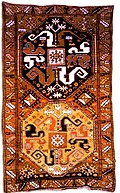Azerbaijani carpet
Azerbaijani rugs (Azerbaijani: [Azərbaycan xalçaları] Error: {{Lang}}: text has italic markup (help)) are carpets made in Azerbaijan, an ancient center of carpet weaving. The Azerbaijani carpet is a traditional handmade textile of many sizes, with dense texture and a smooth or rough surface, whose patterns are characteristic of Azerbaijan's many carpet-making regions. Traditionally, since ancient times the carpets were used in Azerbaijan to cover floors, decorate interior walls, sofas, chairs, beds and tables.[1]
Carpet making is a family tradition transferred orally and through practice, with carpet making and rug making being almost women's job. In the past every young girl had to learn the art of weaving carpets, and the carpets she wove became a part of her dowry. In the case of a newly married son, it was his mother who wove a large rug for his new household. Starting a new carpet meant a feast, but the completion of a rug meant an even greater celebration for the family. In the old days finished carpets were laid out in front of the house so that passers-by with the weight of their feet could make them even tighter than they had already been knotted. For the traditional process of carpet and rug making, men removed the wool from the sheep in the spring and autumn, while women collected dyestuffs and spin and dye yarn in the spring, summer and autumn. Azerbaijani carpets are divided into four large regional groups: Quba-Shirvan, Ganja-Kazakh, Karabakh, and Baku.[1]
In November 2010 the Azerbaijani carpet was made a "Masterpiece of Oral and Intangible Heritage" by UNESCO.[1][2]
Tradition
The rugs have unique patterns with characteristics of Azerbaijan's carpet-making regions. These carpets are used to cover floors, decorate interior walls, sofas, chairs, beds and tables.[3]
Carpet making is a Azeri family tradition, carpet making and rug making is solely a women's occupation. In the past, every young girl had to learn the art of weaving carpets. If a son of a family is newly married, it was his mother who wove a large rug for his new household. Traditionally, men sheared the sheep in the spring and autumn, while women dyed the yarn in the spring, summer and autumn.
Azerbaijani Carpet Media
A 19th century Azeri shadda. Exhibited at the Textile Museum (Washington, D.C.)
Silk embroidery, 17th–18th century. In the collections of the Textile Museum (Washington, D.C.)
Prayer rug from Shusha. 19th century.
A Karabakh carpet of the Malibayli sub-group. Malibayli village of Shusha, 1813
Related pages
References
- ↑ 1.0 1.1 1.2 The traditional art of Azerbaijani carpet weaving in the Republic of Azerbaijan
- ↑ "Azerbaijani carpet entered UNESCO List of Intangible Cultural Heritage". Archived from the original on 2012-03-11. Retrieved 2015-06-23.
- ↑ "UNESCO - Traditional art of Azerbaijani carpet weaving in the Republic of Azerbaijan". ich.unesco.org. Retrieved 2021-04-16.
Other websites
![]() Media related to Rugs and carpets of Azerbaijan at Wikimedia Commons
Media related to Rugs and carpets of Azerbaijan at Wikimedia Commons






